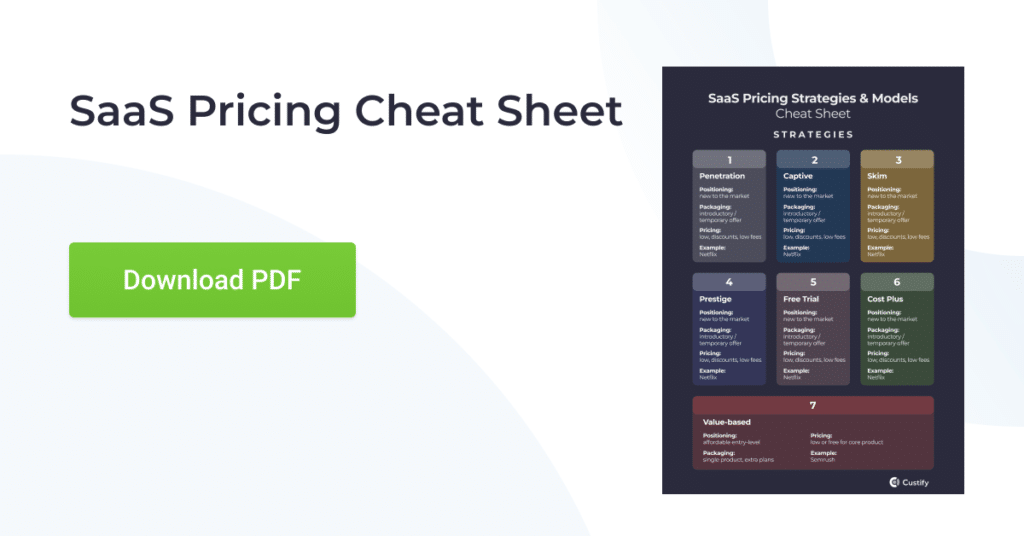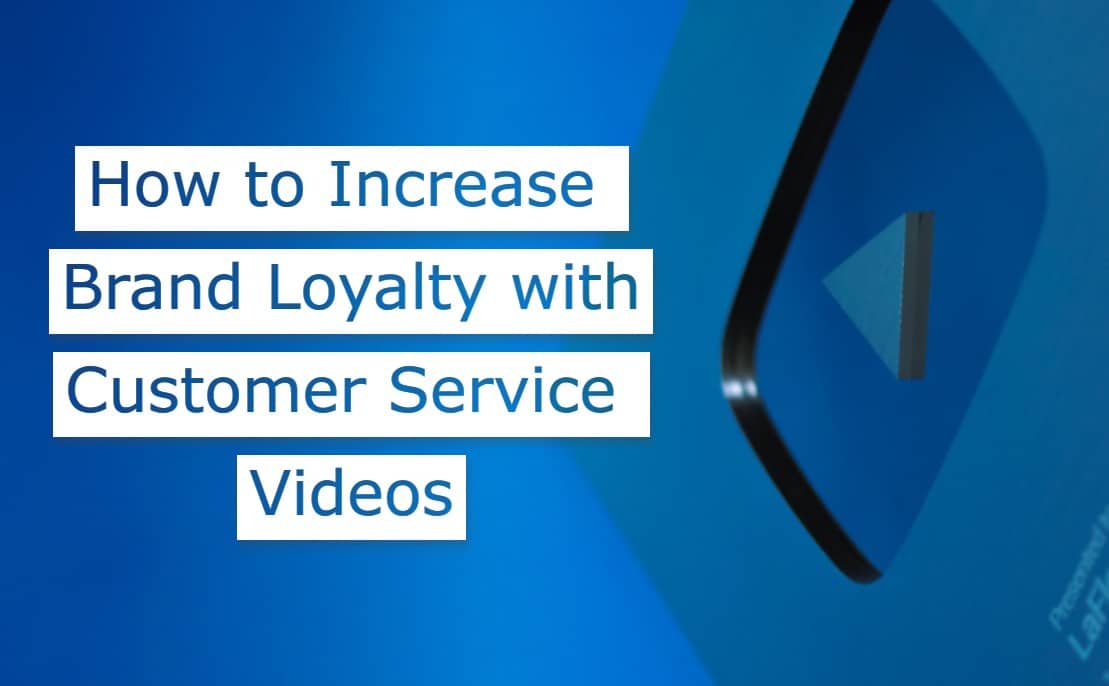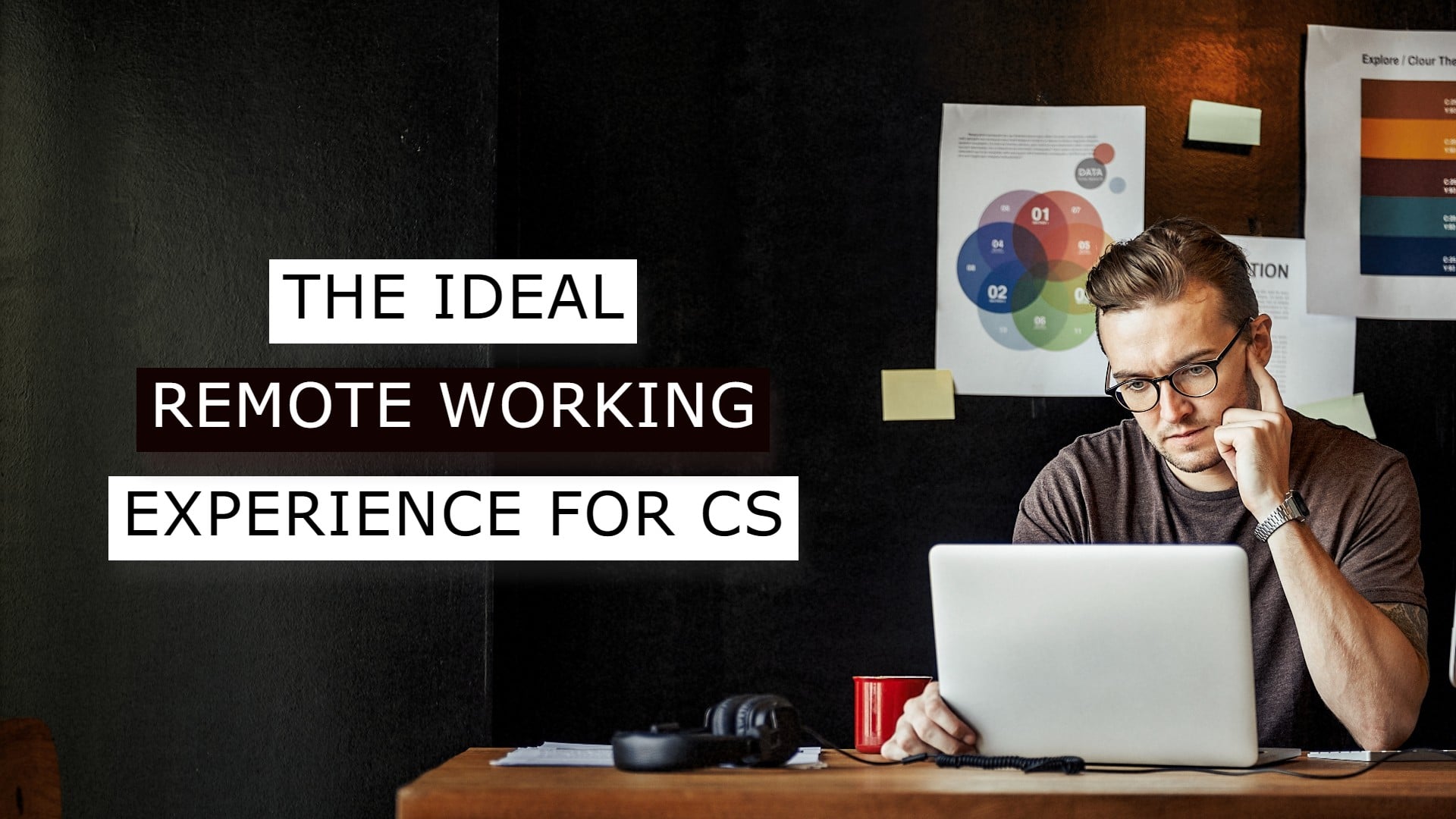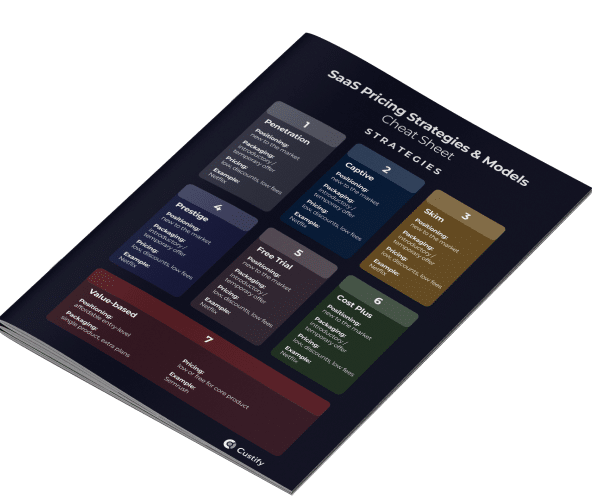Your SaaS pricing strategy and model can tip the scales between your success and failure as a business.
It’s true. Think of it this way: if Adobe didn’t offer free trials and freemium downloads, their products would’ve never had the global reach they have today.
So putting a bit of conscious effort into your pricing strategy is essential to making your SaaS business effective. The real question is, should you go for free trials? Skim Pricing? What even is a flat rate?!
Rest assured – the following review of SaaS pricing models and strategies will explain:
- The differences between SaaS pricing models and strategies, how they go hand in hand, and how this should inform your decision.
- A SaaS pricing cheat sheet designed to give you a bird’s-eye view of your options and decide which one works best for your business.
- A breakdown of all the SaaS pricing strategies with pros and cons, business considerations, and examples for each.
- A similar rundown of SaaS pricing models.
- How customer success can ensure your ROI for whatever model you choose.
SaaS Pricing Strategies vs Models
The answer here is simple: pricing strategies contain pricing models, not the other way around. To help find the line between the two, we’ll look at the definitions:
What Are SaaS Pricing Strategies?
A pricing strategy encompasses the overall philosophy, guiding principles, and strategic objectives that determine the positioning, packaging, and pricing model of a product or service.
Within SaaS, a pricing strategy will almost always contain a type of subscription representing customers’ agreement to the “as-a-service” model of paying for the continued use of the product or service. However, that subscription can take many forms based on the pricing model, the customers, and the market in which the business operates.
What Are SaaS Pricing Models?
Pricing models designate the structure and format of the price and how the product or service is packaged and sold. Within SaaS, it’s typically easy to tell which pricing model a business is following by simply reviewing their pricing page.
Pricing models typically require you to strike a balance between your ability to provide value to your customers while scaling up, and your ability to remain solvent during the entire process.
Why Download the Pricing Guide?
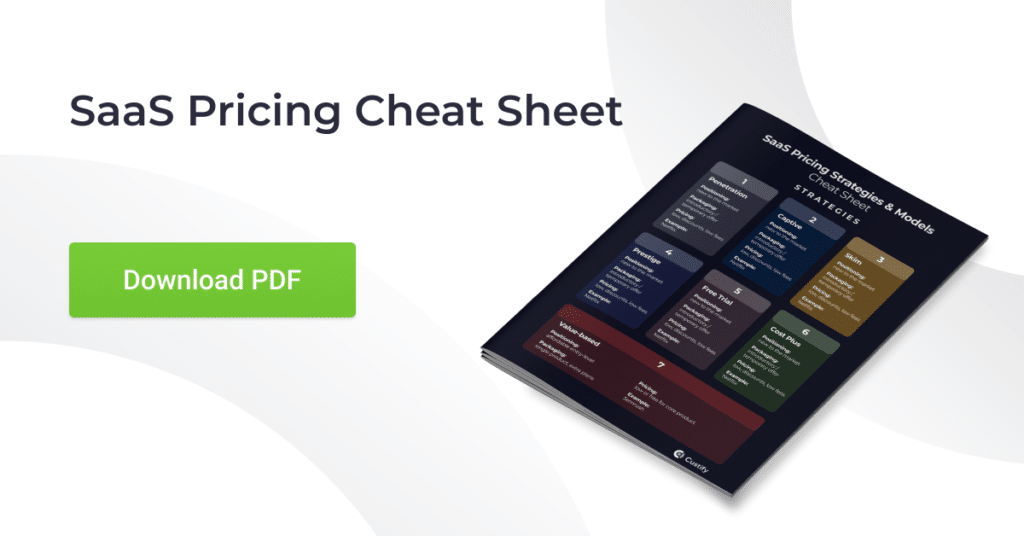
The cheat sheet above can be all you need to settle on your pricing model and strategy. Of course, it’s recommended that you do as much research as possible, but here we’ve tried to condense the information into easily digestible blocks. The result is a printable SaaS pricing cheat sheet that allows you to:
- Pick an appropriate Pricing Strategy for your product or service.
- See which Pricing Model matches your strategy, customers, and market.
- Experiment, mix and match, and see your range of options.
- Make a decision based on industry knowledge, expertise, market fit, and customers.
- Don’t be afraid to raise your price. In certain situations, it can significantly increase revenue:
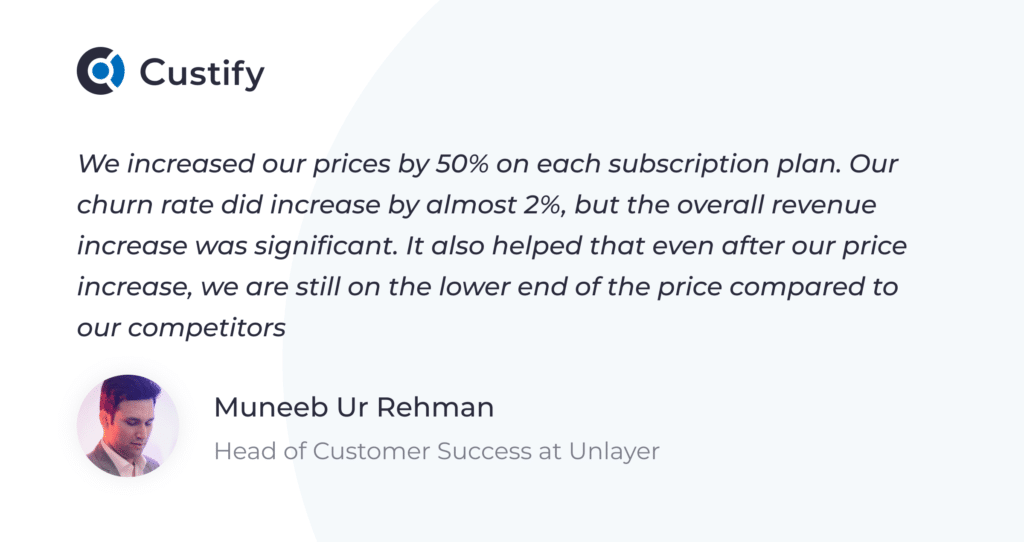
💡 Pro Tip – Don’t A/B test pricing. It might seem like a good idea at first, but here’s the hard truth:
- Your sample size will always be too small to be statistically significant.
- If you aim for a larger sample size (provided you have enough traffic and conversions), the time you’ll spend gathering and analyzing data will clog up your schedule and prevent you from working on more important business areas.
- A/B tests for pricing should account for your buyer personas – which will likely be varied – so out of the gate, you’re splitting your sample size into smaller, even more statistically irrelevant groups.
SaaS Pricing Strategies
Let’s run down the list of pricing strategies with as much detail as possible for each:
1. Penetration Pricing
What Is Penetration Pricing?
The key to the Penetration Pricing strategy lies in its name – with this strategy, you’re trying to enter a market. It’s a great move if your business is new or if you’re doing some radical changes that will shift your target audience and open up a new market for you.
Through Penetration Pricing, you’re essentially pushing the urgency of subscribing if your customers want to get the better deal. The downside, of course, is that many will be left out and you’ll have to deal with price increases down the line.
- Positioning: typically new on the market
- Packaging: introductory offer or another type of temporary, limited offer
- Pricing: lower than normal, either through discounts or lower fees
Pros and Cons of Penetration Pricing
[wpdatatable id=1 table_view=regular]
Is Penetration Pricing Good for Your Business?
100% yes if your product or service is new. There might be other strategies that may fit your particular case better, but Penetration Pricing is a great one for an up-and-coming business with a killer SaaS product. However, remember that Penetration Pricing only has short-term advantages – moving beyond the initial stages of your SaaS, you’ll want to think about pivoting to a pricing strategy engineered for long-term growth.
Examples of Penetration Pricing
For some examples, let’s look at streaming giants and how they price their SaaS when entering new markets. Companies like Netflix, Amazon, and Paramount have all offered discounts, special deals, and extended subscriptions to their respective streaming services as part of their push into new markets.
Netflix has long been a master at Penetration Pricing, as it used this exact strategy in its price war to usurp Blockbuster back in the 90s. While Blockbuster was charging $4.99 for one DVD rental, Netflix entered the market charging $1 per DVD while at the same time eliminating late fees and increasing the rental period. The result? A textbook example of the potential impact of your pricing strategy:
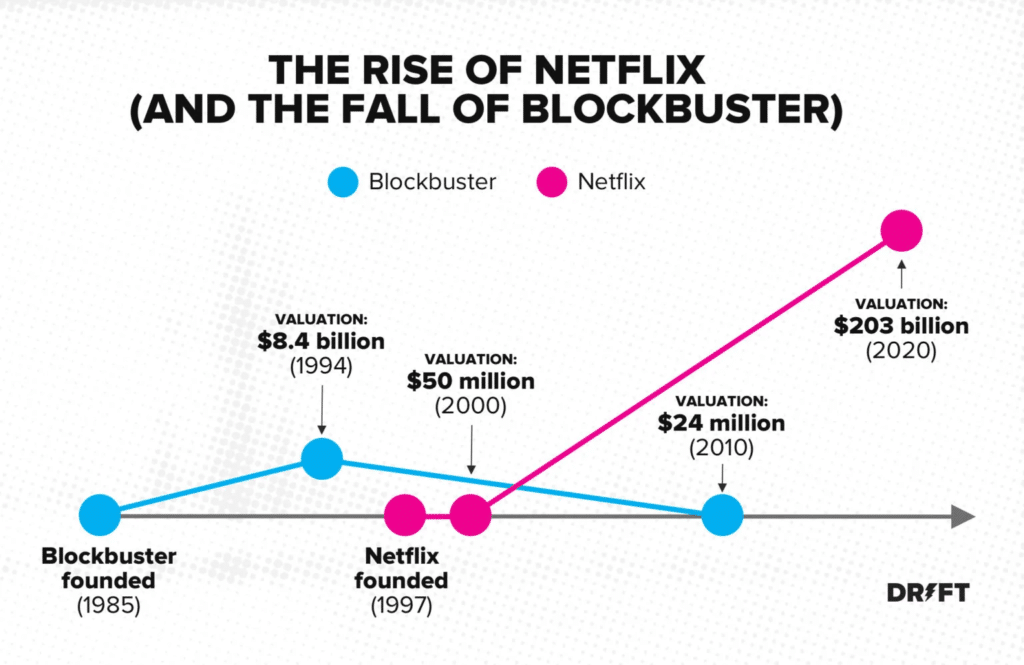
Source: Drift.
2. Captive Pricing
What Is Captive Pricing?
Captive Pricing, or Captive Product Pricing, is a common strategy that we can see in many online SaaS. It involves selling the core product at a lower cost while offering paid options for extra features, connected products, or complementary services that allow your customers to make the most out of their subscription.
Captive Pricing can be contrary to customer success – as many users will be frustrated to find they can’t accomplish their goals without paying for extra features. As such, a conscious application of Captive Pricing that accounts for customers’ desired outcomes would be the ideal way to go.
- Positioning: affordable entry-level product with powerful add-on features
- Packaging: single product with additional paid features or plans
- Pricing: low or free for core product, mid-to-high cost for extras
Pros and Cons of Captive Pricing
[wpdatatable id=2 table_view=regular]
Is Captive Pricing Good for Your Business?
Captive Pricing can be a great solution to your user acquisition concerns. If your product is complex and has a high starting price, consider offering a more affordable or free plan that excludes many of your features without eliminating the core functionality of the product.
It’s tempting to remove as many features as possible and offer the product for basically nothing, isn’t it? But remember, if you do that, you’ll have a lot of new users who immediately churn, minutes after creating their accounts.
Examples of Captive Pricing
For a traditional example of this strategy that everyone knows, we can look at printers. The devices themselves have always been surprisingly affordable – if you don’t know about the Captive Pricing strategy. If you know, you’ll immediately realize manufacturers don’t get their ROI from printers but from cartridges – required add-ons without which the main product would not function.
As for SaaS, we can simply look at Ahrefs. If you open their pricing page, their plans start at $99 and only go up from there. However, a while back, they likely understood this is a barrier to acquisition for a big segment of their audience (freelancers and agencies), so they created a separate, free plan that uses Captive Pricing.
The solution isn’t simply a diet version of the main product, but a functional, useful, and rebranded tool for anyone in their audience. It provides a great stepping stone to product adoption, while enticing users to purchase a subscription due to many features still being locked. What’s more, since the plan is both free and a valuable tool to have, users from their direct competitor, Semrush, are likely trying it out.
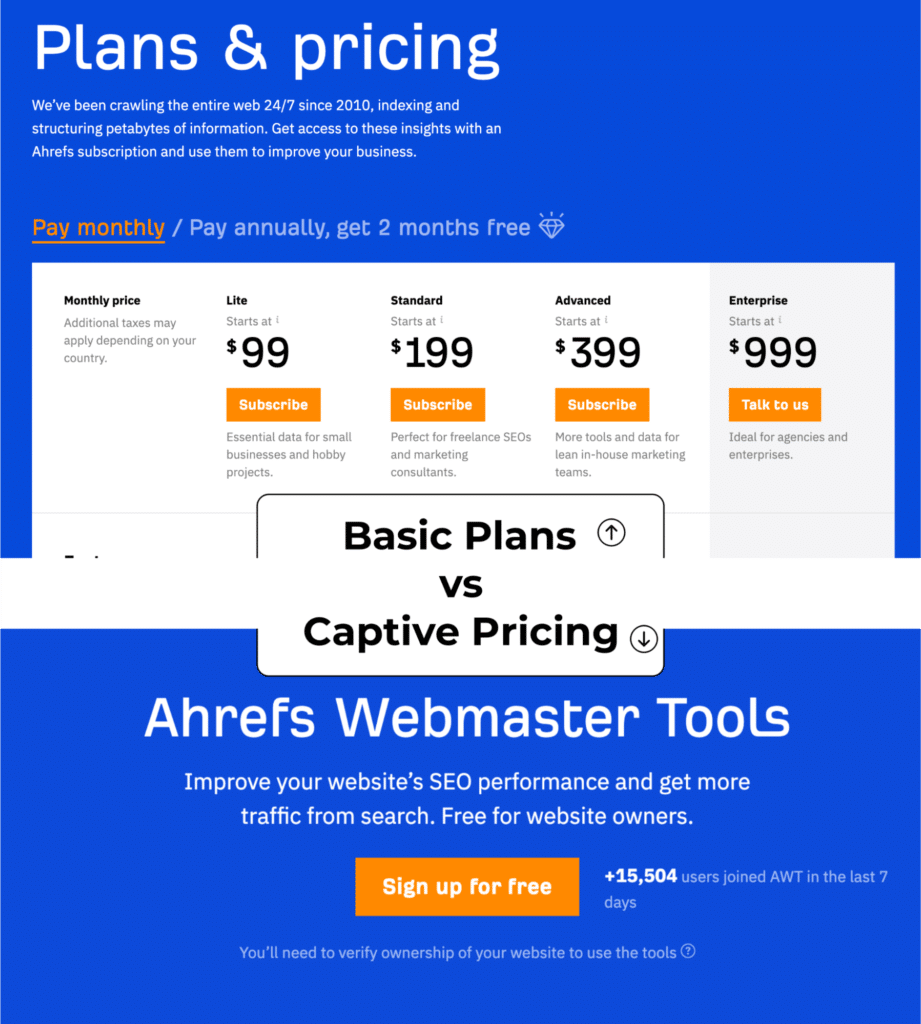
3. Skim Pricing
What Is Skim Pricing?
Skim Pricing, Price Skimming, or Skimming Pricing is a tactic that essentially means pricing your product or service as a lot more expensive than expected, then lowering the price gradually.
The best products or services that can take advantage of price skimming are new, exciting, innovative products as they can be presented as a premium alternative to existing market offers.
- Positioning: new, exciting, innovative, and premium products & services
- Packaging: exclusive offer, high-quality designs to sell the premium aspect
- Pricing: high, goes down over time
Pros and Cons of Skim Pricing
[wpdatatable id=3 table_view=regular]
Is Skim Pricing Good for Your Business?
For Skim Pricing to work, it really comes down to your product. If what you’re offering is a game-changer – it might make sense to go for this pricing model, provided you account for all the flak you’ll receive from those who dislike the apparent greediness of the approach.
Examples of Skim Pricing
The best example of Skim Pricing is Apple – in all of its products, both software and hardware. All of them start with a price tag that’s shocking for some, yet they bank on a loyal fanbase who chase the feeling of exclusivity you get from purchasing something high-end. It’s a big trade-off, so ultimately, there are few companies who can pull it off.
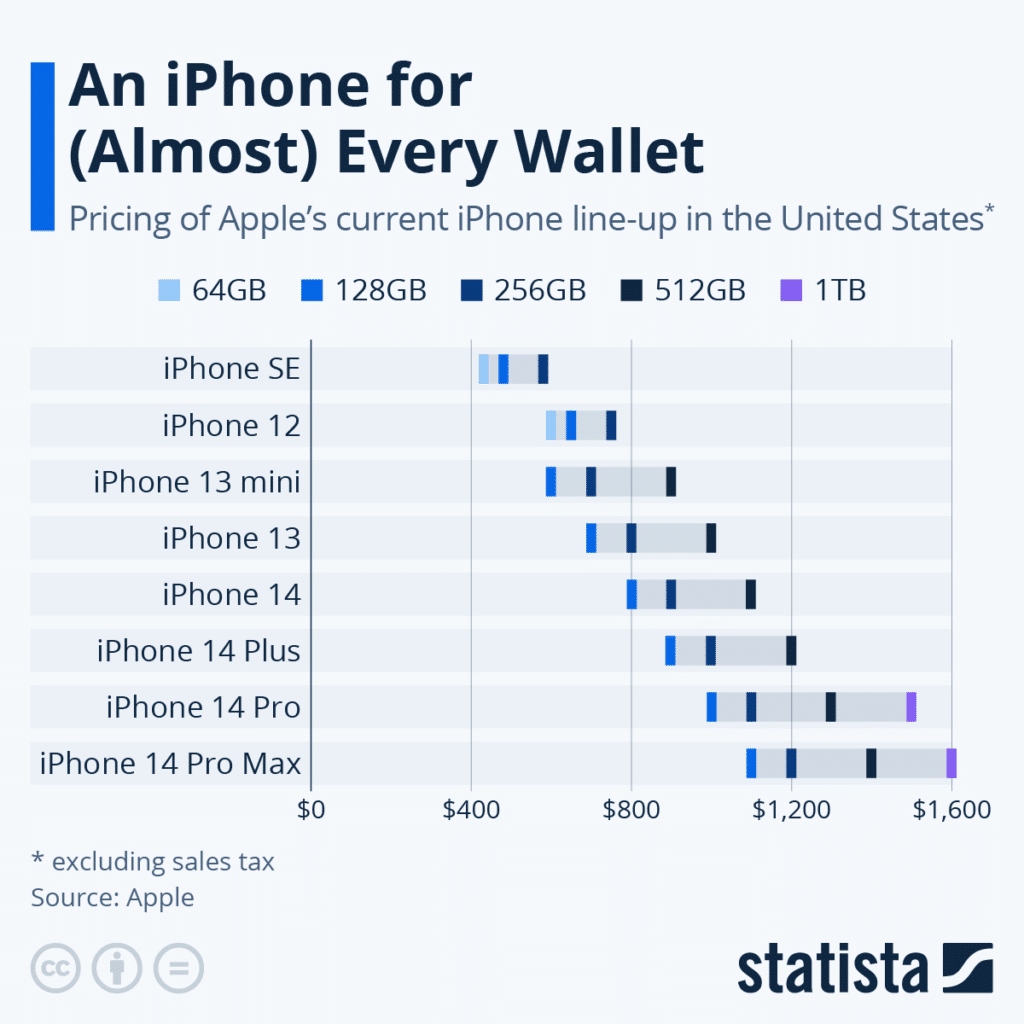
Example of Skim Pricing: even the cheapest iPhone available still costs upwards of $500.
Source: Statista.
4. Prestige Pricing
What Is Prestige Pricing?
Prestige Pricing, or Premium Pricing, is the de-facto pricing strategy of most for most luxury, high-end, exclusive products. It involves maintaining a high price that’s generally tied to the same feeling of high-quality and exclusivity we’ve seen with Skim Pricing. However, unlike that strategy,
Prestige Pricing doesn’t see costs lower over time, as doing so generates questions for the high-end audience like: is there a quality drop? a value decrease? should I keep paying for this product?
- Positioning: luxury, high-end, high-quality, exclusive
- Packaging: single offer, rounded price (i.e., $300 instead of $299.99)
- Pricing: high and stays high for the entire product lifecycle
Pros and Cons of Prestige Pricing
[wpdatatable id=4 table_view=regular]
Is Prestige Pricing Good for Your Business?
If you’re trying to enter a market as a high-end alternative to your competitors, Prestige Pricing is perfect for you. However, your product and CS teams should ensure the quality of service you’re providing is up there with the price you’re asking. If there’s a gap between the two, your customers will immediately sense the disconnect and potential scam for their money. So only go for Prestige Pricing if you’re 100% sure you can offer a Prestige Product (or service).
Examples of Prestige Pricing
There are plenty of examples of Prestige Pricing. We simply have to look at luxury brands: Tom Ford, Adidas, Lexus, Corvette, Seiko, and more – all have products with astronomical prices compared to similar products from their competitors.
For SaaS products, Prestige Pricing is less common – but it still exists. One example I’d put under this strategy is Hubspot’s Sales Hub – which has fixed professional and enterprise plans, with the latter starting at €14,160/yr, plus a one-time onboarding fee of €2,930.
5. Free Trial Pricing
What Is Free Trial Pricing?
Free Trials are everywhere in the SaaS world – from Google to random & obscure mobile games. There is a big advantage in allowing your audience to get a look at your services before converting. A free trial strategy is also limited – typically for up to one month – forcing users to make a decision before that time comes. When the deadline arrives, most vendors automatically bill the customer – increasing revenue through automation.
- Positioning: entry-level product for people to try
- Packaging: limited-time free trial with a fraction of the features of the core product
- Pricing: free for a set amount of time
The Free Trial Pricing strategy also comes in two models:
- Opt-in Free Trial. Users get access to the product without providing payment information and must opt-in to subscribe at the end of the trial period.
- Opt-out Free Trial. Users get access to the product only if they provide payment information, and must opt-out to not get billed at the end of the trial period.
Learn more about these two models and improving free trial conversions in our separate guide.
Pros and Cons of Free Trial Pricing
[wpdatatable id=5 table_view=regular]
Is Free Trial Pricing Good for Your Business?
Free trial Pricing is a great way of convincing your audience of your product’s capabilities. For software, there’s no better way of showcasing your product than by allowing your customers to test it out in a free trial.
Also, consider how many features you’d like in the free trial package – some SaaS offer the full product to trial users in the hopes of convincing them to subscribe. On the other end of the spectrum, you have products that only offer a very limited set of features to free users.
It’s up to you to find the best spot for your SaaS on this spectrum.
Examples of Free Trial Pricing
The best example of an Opt-Out Free Trial Pricing strategy is Adobe Creative Cloud. All of their many products come with the option of a free trial. Then once trials end, users are automatically billed for a yearly subscription.
It can be annoying, but it’s certainly also effective at generating revenue for Adobe and securing a period of at least one year for a percentage of free trial users to see the value of the product (including the many upgrades that Adobe puts out during that time).
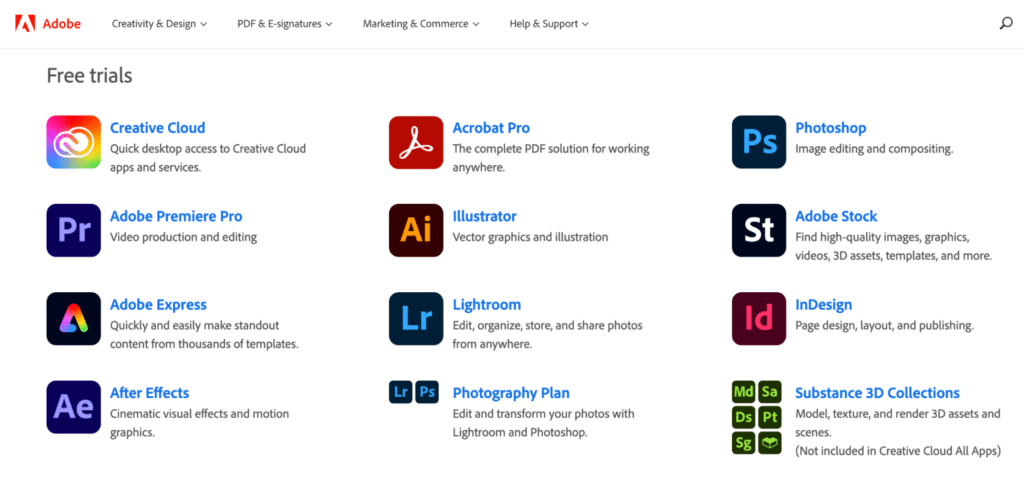
Source: Adobe.com
6. Cost Plus Pricing
What Is Cost Plus Pricing?
Likely the “coldest” pricing strategy on the list, Cost Plus presents a simple business formula for calculating your most straightforward price possible, with no considerations regarding the market, the customers themselves, or any future trends.
The best way to achieve success with Cost plus Pricing is through total transparency as to what goes into your price – banking on your customers appreciating the progressive business strategy.
The Cost Plus Pricing formula is:

Check out our article on customer acquisition cost for more info.
- Positioning: newcomer to the market with transparent, fixed cost
- Packaging: each plan is engineered for specific price categories
- Pricing: tied directly to the formula
Pros and Cons of Cost Plus Pricing
[wpdatatable id=6 table_view=regular]
Is Cost Plus Pricing Good for Your Business?
It’s difficult to say whether Cost Plus Pricing is good for you – it depends on your business specifics. However, it is the safest option you can go for with much less time spent on meetings and research compared to all your other options.
Examples of Cost Plus Pricing
The best example of Cost-plus Pricing is Everlane – a clothing retailer that reveals everything about the costs of producing, manufacturing, and delivering its products:

Source: Everlane.
7. Value-based Pricing
What Is Value-based Pricing?
On the other end of the spectrum, radically opposed to Cost-based Pricing, we have Value-Based Pricing. This strategy focuses on how much value customers will receive from the product or service, and how much the target audience would be willing to pay based on that value estimate.
The biggest challenge with Value-based Pricing is figuring out the marketing machine that will convince your audience of the perceived value of your product.
- Positioning: useful, valuable product, better than the competition
- Packaging: use market and customer data to create value-based packages that customers would be willing to pay for
- Pricing: varies based on demand, product features, and market segments
Pros and Cons of Value-based Pricing
[wpdatatable id=7 table_view=regular]
Is Value-based Pricing Good for Your Business?
Interestingly enough, Value-based Pricing is the first strategy on our list to rely heavily on how the market moves. If your market is highly volatile, you might be susceptible to unpredictable changes in how your product’s value is perceived. When that happens, it becomes challenging to justify your high price point.
Examples of Value-based Pricing
A great example of a company that’s been strategic about its Value-based Pricing is Starbucks. The Seattle-based coffee chain sells its beverages at a significantly higher cost than many of its competitors. The coffee is good, but not enough to justify the price.
So what happened?
Inspired by Milan’s coffeehouses, Howard Schultz brought “the warmth and artistry of its coffee culture to Starbucks,” refocusing the company, and growing the perceived value of the Starbucks experience from simple coffee shops to fully-equipped spaces for work and relaxation with a large variety of drink options, both hot and cold, all backed by expert baristas with great customer service skills.
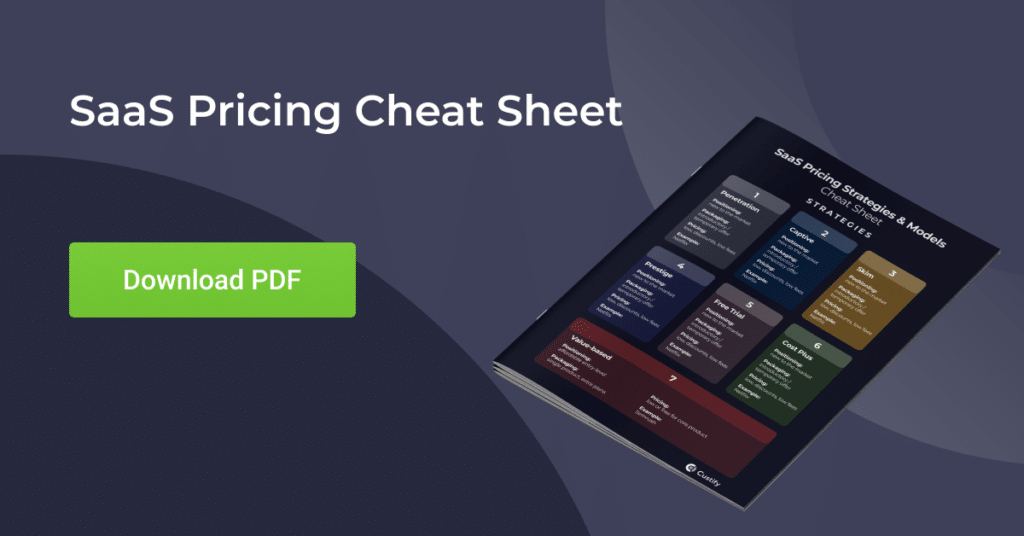
SaaS Pricing Models
Your strategy might be all set, but without implementing a proper pricing model, it will always be incomplete.
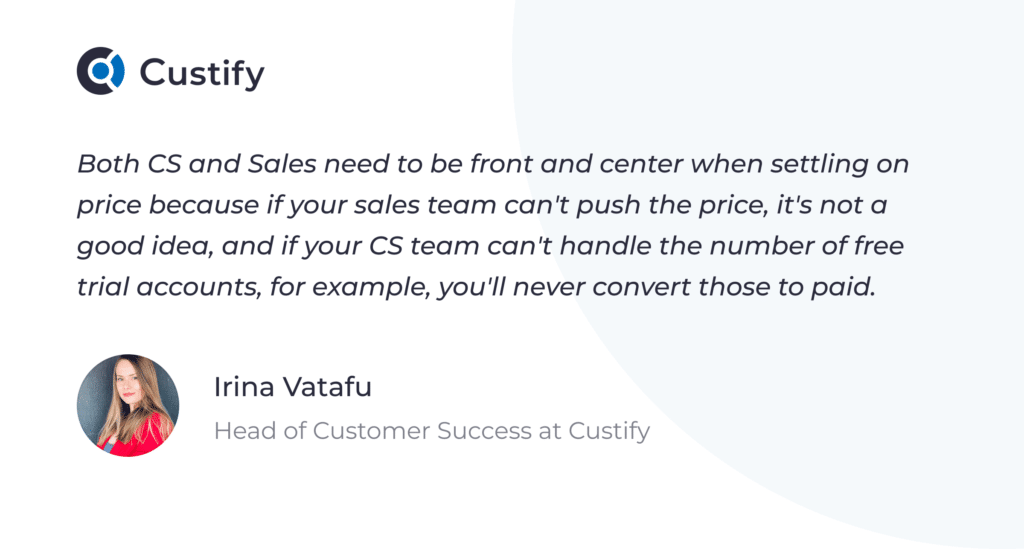
1. Flat-rate Pricing
What Is Flat-rate Pricing?
Flat Rate pricing is a model focusing on a single flat price for the entire user base. It might seem a bit reductive and simplistic, but in many cases, it’s the right way to go.
Flat rate pricing means all customers have the same features – which might put undue stress on your support team which has to service everyone at the same level – including users who might not understand or need to use specific features. On the upside, however, it’s the quickest way to get done with pricing and you’ll only have one plan to sell.
Pros and Cons of Flat-rate Pricing
[wpdatatable id=8 table_view=regular]
Is Flat-rate Pricing Good for Your Business?
Flat-rates are great if you target individual users instead of groups like agencies or full businesses. The simpler and more straightforward your product, the easier it is to set a flat price for your subscription.
Examples of Flat-rate Pricing
For a simple example of Flat-rate Pricing, we can look at news media outlets. The New York Times has a flat price of $0.50/week regardless of how many articles you read or how many Wordles you complete.
2. Usage-based Pricing
What Is Usage-based Pricing?
Yet another straightforward pricing plan, the Usage-based model is essentially a way to let users pay for exactly how much they use of your product or service. That means that by the end of the billable period, extra costs typically add up to raise your subscription cost.
Usage-based Pricing typically works by assigning a price to a unit specific to the service or product being sold (such as subscription hours, cloud storage space, and more).
Pros and Cons of Usage-based Pricing
[wpdatatable id=9 table_view=regular]
Is Usage-based Pricing Good for Your Business?
If your product has units you can assign a price to, it might be a good idea to go for a usage-based pricing model. However, you also need to be upfront about it and foster an honest relationship with your customers so that they don’t incur unforeseen costs and churn. This is a great point for CS to step in as they can both optimize account costs and upsell customers based on their needs.
Examples of Usage-based Pricing
A traditional example of usage-based pricing can come from your utilities. Think electric, gas, water bills, and so on. In most areas, you’re paying based on how much you use.
A great modern example is AWS, which uses a Pay-as-you-go model paired with volume-based discounts that help large enterprises lower their costs.
3. Tiered Pricing
What Is Tiered Pricing?
Likely one of the most common pricing models, Tiered Pricing involves having multiple packages with various prices based on features and / or services that you’re offering. It’s also a safe option for most SaaS businesses, the downside being it takes time and research to reach an optimal version for your pricing tiers.
Pros and Cons of Tiered Pricing
[wpdatatable id=10 table_view=regular]
Is Tiered Pricing Good for Your Business?
Tiered Pricing is a standard model, especially within SaaS. However, it can be limiting to force your customers into set plans. Based on the nature of your product, market, and customers, tiers might suit you, or you might need something more. In that case, consider Per-feature Pricing as a good alternative.
Examples of Tiered Pricing
Most online businesses have Tiered Pricing. Here’s an example from Semrush:
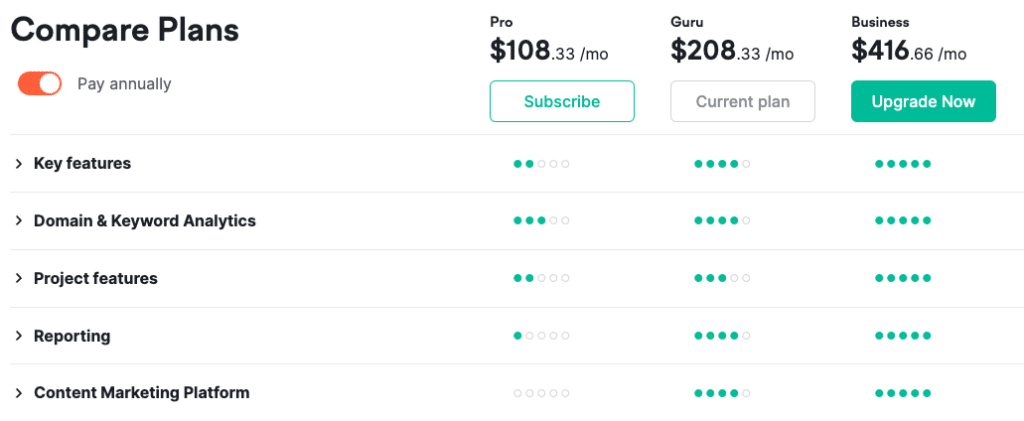
4. Per-user Pricing
What Is Per-user Pricing?
The Per-User Pricing model is exactly what it sounds like – you come up with a price point for one seat (or user) and then you use that price at scale. This model is frequently paired with milestone discounts or tiers based on how many users an account has.
What’s more, you can even create multiple tiers for user plans, essentially optimizing your entire pricing strategy to service all possible customers in terms of both quantity of users and number of features.
Pros and Cons of Per-user Pricing
[wpdatatable id=11 table_view=regular]
Is Per-user Pricing Good for Your Business?
If your customers aren’t in their growth phase, it might be ideal to price your product or service per-user. It’s also a great way to reduce sales workload if you have the tools and budget to automate and optimize your signup flow. Just remember it’s not often enough to simply pick a price point for your users – most business pair that with Tiered Pricing.
Examples of Per-user Pricing
Case in point, if you look at the same Semrush plans above, you can see they have the option to add users for each tier at different price points:

5. Per-active-user Pricing
What Is Per-active-user Pricing?
Per-active-user Pricing is a model that aims to address a major drawback of Per-User Pricing. It ensures that customers only pay for accounts that are actively used and not for those that are idle or inactive.
In many cases, businesses that use Per-User Pricing require enterprise customers to pay an annual subscription. However, those enterprises might have layoffs or some of their users might simply stop using your product. In that case, it can be very frustrating for your customers to pay for licenses they’re not using.
That’s where Per-active-user Pricing comes in, effectively charging only for the accounts that actually show signs of activity.
Pros and Cons of Per-active-user Pricing
[wpdatatable id=12 table_view=regular]
Is Per-active-user Pricing Good for Your Business?
Perf-active-user Pricing works best for businesses with large enterprises as customers – it poses a big competitive advantage if you’re the only one doing this, and it brands you as a fair player on the market that cares about its customers.
Examples of Per-active-user Pricing
A famous example of Per-user Pricing comes from Slack in the form of a “Fair Billing Policy”:

Source: Slack Help Center
6. Per-feature Pricing
What Is Per-feature Pricing?
Per-feature Pricing is the most customizable model one can use, from a customer’s perspective. It allows your potential clients to fine-tune their subscriptions by adding features or services to suit their needs and achieve success. Typically, Per-feature Pricing uses a Pricing Calculator.
The biggest downside is the amount of development it takes to implement such a complex signup flow. On the upside, you could be dramatically reducing customer churn by having your CSMs help customers identify the best product features or services to fit their desired outcomes and then creating a personalized offer for them.
Per-feature Pricing also works well for increasing trial-to-paid conversions, as you can follow the process above with increased efficiency for accounts that are already tracked in your customer success dashboards.
Pros and Cons of Per-feature Pricing
[wpdatatable id=13 table_view=regular]
Is Per-feature Pricing Good for Your Business?
Per-feature Pricing works better the more features you have. If you have a simple product, it might not make much sense to spend resources on building a complex signup flow. However, if it makes sense for your product, Per-feature Pricing can be a powerful driver for growth and customer success.
Examples of Per-feature Pricing
The best example of Per-Feature Pricing comes from AWS, which uses it in conjunction with Usage-based Pricing.
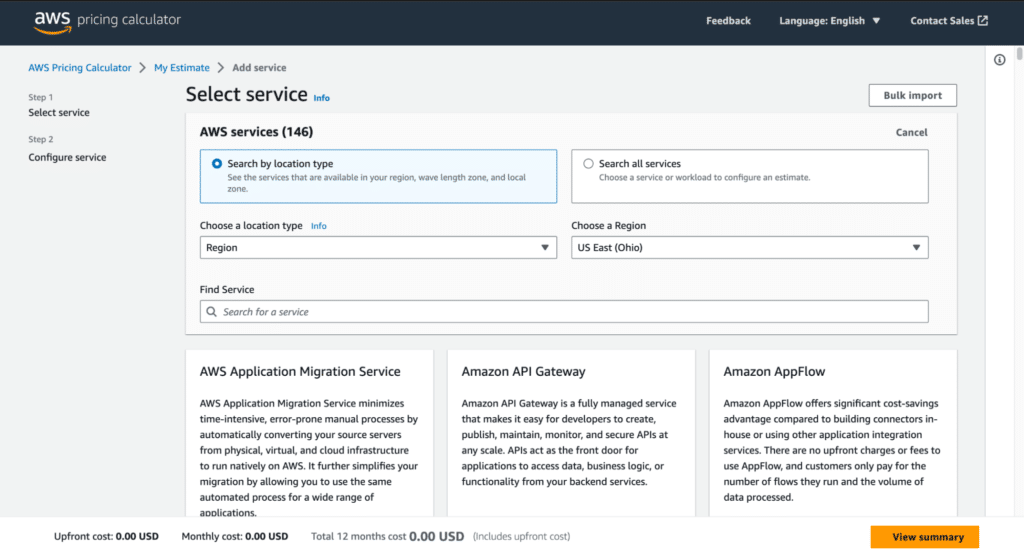
The Pricing calculator from AWS allows users to filter available services by location. For each service a user selects, a pop-up appears that allows them to customize its specifics before adding it to the subscription and instantly updating the monthly cost.
7. Freemium Pricing
What Is Freemium Pricing?
It may sound similar, but the Freemium Pricing model is not the same as the Free Trial Pricing strategy. While the latter focuses on pushing free trials to grow the user base, the Freemium model is built around giving users a fully-functioning free-to-use product (i.e. a freemium product), then giving them options to upgrade to a paid plan for various added benefits).
Pros and Cons of Freemium Pricing
[wpdatatable id=14 table_view=regular]
Is Freemium Pricing Good for Your Business?
Freemium Pricing has the potential to work very well for most businesses if they have:
- The budget to support a large number of free accounts
- The infrastructure necessary for the product to stay up during high traffic demands
- An attractive range of paid options and plans that can balance the costs of maintaining and supporting free accounts
Examples of Freemium Pricing
Most social media companies and other B2C online businesses make use of freemium pricing:
- LinkedIn and LinkedIn Premium
- YouTube and YouTube Premium
- Slack and Slack Pro
- Most cloud storage services
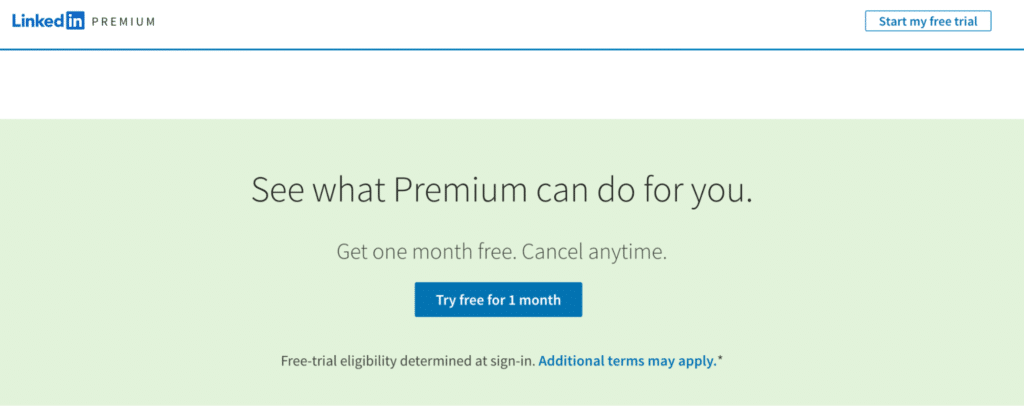
What’s the Most Popular SaaS Pricing Model?
Tiered Pricing is, by and large, the most common pricing model – simply because most SaaS companies have an average of 3.5 pricing packages, according to global SaaS pricing statistics.
But as we’ve seen above with the Ahrefs example, that doesn’t mean they only use Tiered pricing. In fact, according to the same source, 50% of SaaS companies also opt for Usage-based Pricing, followed closely by Value-based Pricing at 39%.
The latter is not that surprising – most SaaS experts agree that your initial price estimate should be a value-based one. Even if you don’t end up showing that price to your customers, it’s good to have an idea of your costs and then see how you can provide customer value that’s higher than those costs.
Another interesting point to note from current trends is that a large majority of SaaS companies change their pricing strategies at least once per year. So don’t get too close to your current strategy – it might not make sense in the long-term. In fact, occasional changes in market trends and consumer behavior might allow you to raise your price without risking customer churn.
Pricing Before or After Product-Market Fit?
For all the SaaS startups out there, I have a serious tip: don’t delay thinking about your pricing until after you’ve developed your product. You’re setting yourself up for a rough ride if you’re just banking on a ‘monetize-later’ approach. Pricing should be part of your initial strategy and it should do hand in hand with product design.
If you want to know if you’ve hit the sweet spot with product-market fit, you’ve got two big questions to tackle: Are customers using my product? And, are they ready to fork over their hard-earned cash for it? Getting paid for your product or a shiny new feature isn’t just a ‘nice-to-have’. It’s a solid thumbs-up that you’ve nailed your product-market fit. Early pricing decisions aren’t just about the money – they’re a stepping stone to real, sustainable growth in the SaaS arena.
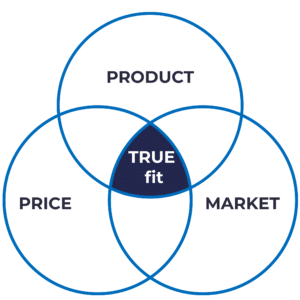
What’s the Best SaaS Pricing Model You Can Pick?
Most of the above SaaS pricing models and strategies can work to drive success for both customers and the business itself. However, it’s all in the specifics. So before going through our cheat sheet above, make sure you clarify the following details:
- What your core market is and how consumers in this space typically behave: what they want from the businesses they patronize, what kind of products they would most use, what kind of UI they prefer, and what the expected churn rate is for a SaaS in this space.
- What your competition is doing: analyze all your competitors’ pricing pages and see what kind of subscription plans your users might expect.
- What your value-based price point is: or how much it costs to develop your product. Many of the pricing strategies and models presented above rely on the actual cost of development (such as Flat-rate Pricing), or benefit from an initial value-based estimate.
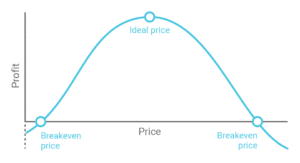

A review of the relationship between your profit and your price point, and the necessary gap between the value of your product per unit and the value it provides to your customers. Graphs by Eric Dolansky, Associate Professor of Marketing at Brock University.
Whatever strategy and model you pick, you will need customer success to bring it to fruition:
- Use your customer success software to monitor customers – particularly for upsells and increasing trial-to-paid conversions.
- CSMs can reach out to customers on customizable pricing plans (like we’ve seen with the Per-feature and Tiered Pricing models) and help them optimize those plans based on usage data.
- For Value-based Pricing, CS and marketing need to optimize collaboration and deliver messaging that truly brings life to the value of your product and convinces users that your price point is worth it.
- For penetration pricing, CSMs can step in early to convince leads of the true value of the product – demo sessions, live demo events, pre-onboarding emails – all of these tactics and more can ensure your business makes a name for itself on the market.
Last but not least, SaaS pricing models and strategies have a direct connection to SaaS valuation models: typically, if the pricing you pick is successful, it will lead to a particular model for growth and value.
Sold Yet?
We’ve gone through all currently known SaaS pricing strategies and models, with detailed and specific info for each, including the types of business for which they make the most sense.
You now have a full breadth of options to consider – so print out the cheat sheet before your next board meeting and be ready to decide! Whatever pricing model you pick, I hope the piece above serves as a useful path to your continued success.
For more detailed breakdowns of complex SaaS topics, don’t forget to check back in with the Custify Blog. Good luck!
